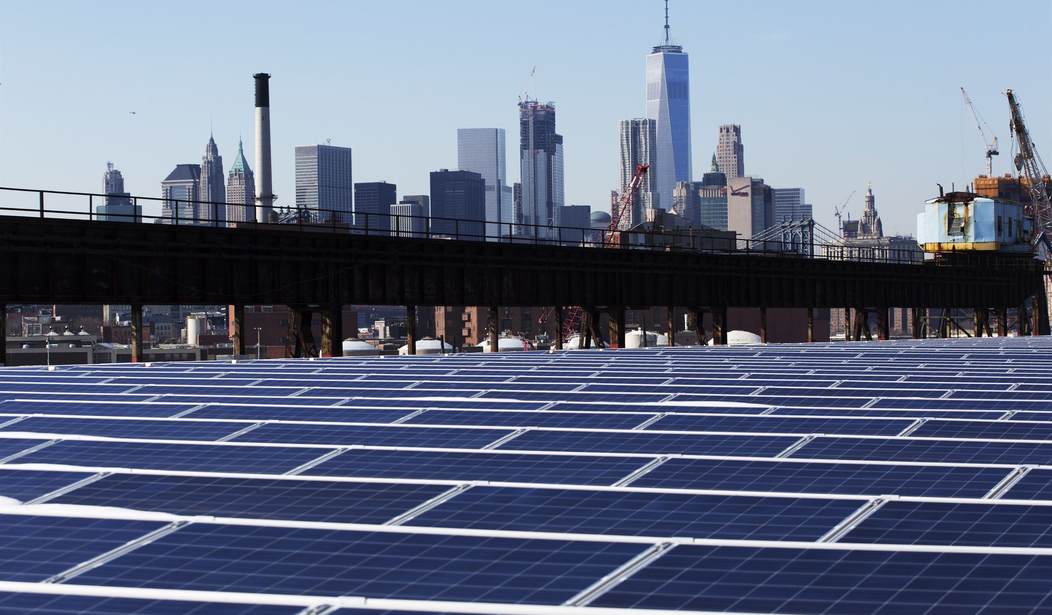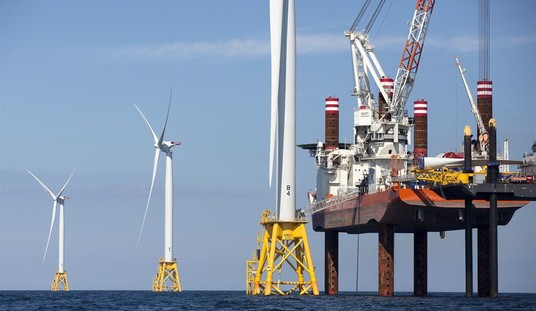Just ask New York state right about now.
Oh, wait – we don’t have to. The Wall Street Journal ran the numbers.
New York spent nearly $1 billion over the past decade on Elon Musk’s ambitious plan for what was supposed to be the largest solar-panel factory in the Western Hemisphere, one of the largest-ever public cash outlays of its kind.
“You almost have to pinch yourself, right?” New York’s then-Gov. Andrew Cuomo said at a construction ceremony for the factory in 2015. “That this is too good to be true.”
Eight years later, that looks like a pretty good assessment.
Everybody’s climbing over each other, handing out the subsidies and tooting their horn they beat everyone else to it.
…America’s governors are swept up in an arms race of awarding packages of taxpayer money to attract industrial megaprojects. Contributing are President Biden’s federal subsidies to build up U.S. manufacturing, particularly for electric-vehicle battery and semiconductor plants, some of which require states to kick in additional incentives.
Last year, states gave each of eight company facilities more than $1 billion in tax breaks and other aid, according to Good Jobs First, a subsidy tracker funded partly by labor unions. Until then, there had never been a year with more than three such deals.
The problem is, the pay-off to expenditure ration is inverted.
As I wrote last week, the bazillions spent on EVs in government subsidies, while awfully nice for the consumer who purchases one, are costing taxpayers their butts as manufacturers either cut-back or flat-out go under.
Case in point is an EV company much bally-hooed by President Trump at the time, at a facility with a history of gobbling subsidies – Lordstown Motors.
That EV start-up was on the site of a former GM car plant, which at one point in the 90s had been the only GM plant in the U.S. manufacturing small cars. You could say Ohio was desperate to keep it, so the money shoveling began long before the EV saga rolled in.
…It’s also the story of how a company can get so powerful in a state that no elected official is willing to risk telling it “no.” According to the Subsidy Tracker Database compiled by Good Jobs First, Ohio government agencies gave General Motors or its subsidiaries more than $235 million in grants, tax breaks or other forms of subsidies between 1990 and 2016 – and that doesn’t include a half-dozen major deals of undisclosed value.
The money is insane.
…In 2002, after threatening to close the plant, GM received a $63 million subsidy deal from Ohio to begin production of the Chevy Cobalt at the plant in 2004. One local county commissioner called it “the best economic news we’ve had probably in the last 30 to 40 years in the Mahoning Valley.” However, the news quickly became much grimmer as the automaker cut 1,100 jobs at Lordstown in 2006 thanks to slowing sales.
Another 2,000 jobs at Lordstown were lost in General Motors’ 2008 bankruptcy, but GM still asked for and received $60.3 million in new subsidies the next year as it retooled the plant to produce the new Chevy Cruze…
In 2019, in spite of tens of millions of dollars, the last Chevy Cruze left the assembly line. GM shuttered that plant, along with 4 others and cut some 6000+ jobs. 6 months later, while under pressure from the Trump administration to make it right somehow, they announced the sale of the Lordstown plant to start-up EV manufacturer Lordstown Motors.
Ohio sued for a return of $60M in credits, but settled for $28M and some regional feel good social spending.
Then the state turned around and whipped out the checkbook again.
…In 2021, Ohio approved Lordstown Motors for $20 million in tax credits and the state’s JobsOhio economic development corporation would also pledge $4.5 million in grants to the prospective automaker. The company, which had coincidentally hired Ohio Gov. Mike DeWine’s 22-year-old grandson as a lobbyist, pledged to employ 600 workers and build 20,000 pickups a year.
In 2021 Lordstown Motors notified federal regulators that it did not have enough money to begin production of its trucks and in 2022 it sold the plant to Taiwanese manufacturer and economic development cautionary tale Foxconn for $230 million. Foxconn said it would use the factory to build electric vehicles for auto brands like Fisker and Lordstown Motors itself.
It turns out Lordstown never had the orders to do what they projected when they sold themselves. Only an investigation afterward revealed it was smoke and money mirrors.
…The investigation found that while Lordstown Motors said on multiple occasions that a majority of the 100,000 non-binding preorders it collected were from commercial fleets, this was not the case. It discovered that “one entity that provided a large number of pre-orders does not appear to have the resources to complete large purchases of trucks,” and that other companies on the list “provided commitments that appear too vague or infirm to be appropriately included in the total number of pre-orders disclosed.” The firm’s probe also confirmed that Lordstown Motors paid a company to drum up around 1,000 preorders.
Foxconn, the Taiwanese ne’er do well chip/iPhone manufacturer and partner in the Lordstown debacle (currently the subject of a breach of contract suit with the motor company) has been tripping the light fantastic with subsidy cash across the MidWest since 2017. This is a terrific piece on their extensive grift list, but the deal that blew up big time was the one that was supposed to save Wisconsin.
The state got bit big time by the shiny snek oil subsidy salesmen. They’re on the hook for everything associated with a bought and infrastructure-prepared $10B (BILLION), 20M (MILLION) square foot manufacturing facility to supposedly make LCDs, while employing 30,000 people…which is still mostly field.
They’re trying to salvage what they can.
…Under a deal with the state of Wisconsin announced on Tuesday, Foxconn will reduce its planned investment to $672 million from $10 billion and cut the number of new jobs to 1,454 from 13,000.
…As of 2019, the village where the plant is located had paid just over $152 million for 132 properties to make way for Foxconn, plus $7.9 million in relocation costs, according to village records obtained by Wisconsin Public Radio and analyzed by Wisconsin Watch.
…The state will reduce the tax credits authorized for the project to $80 million from $2.85 billion.
The original Wisconsin package also included local tax incentives and road and highway investments by state and local governments, which brought total taxpayer-funded subsidies to more than $4 billion.
…The state has already spent more than $200 million on road improvements, tax exemptions and grants to local governments for worker training and employment, according to the records obtained by Wisconsin Public Radio.
Don’t think the Foxconn (“conn” being the operative word) snek oil salesmen are giving up – oh, no. The have big future plans for the site. WHEEE!
Call me a cynic, but I’ll bet it has something to do with schweet CHIPS Act cha-ching…
That’s a three-month old video, and that is all the “factory” the taxpayers of WI have to show for their money six years into this.
As far as Elon’s solar panel factory, which Tesla is contracted to rent for $1 year through 2029, it’s not quite as gleaming in the distance as advertised. What a surprise
…The Tesla solar-energy unit behind the plan, however, is averaging just 21 installations a week, according to energy analysts at Wood Mackenzie who reviewed utility data. The building houses some factory workers, but also hundreds of lower-paid desk-bound data analysts working on other Tesla business.
The suppliers that Cuomo predicted would flock to a modern manufacturing hub never showed up. The only new nearby business is a Tim Horton’s coffee shop. Most of the solar-panel manufacturing equipment bought by the state has been sold at a discount or scrapped.
A state comptroller’s audit found just 54 cents of economic benefit for every subsidy dollar spent on the factory, which rose on the site of an old steel mill. External auditors have written down nearly all of New York’s investment.
…The state has agreed to amend the terms of its subsidy 12 times over the years, including by reducing the number of jobs to be created in manufacturing and shifting deadlines to accommodate the company.
Although there aren’t as many manufacturing jobs as the company and politicians had forecast, Tesla reported in February it has created 1,700 positions there, enough to meet its obligations to the state and avoid a $41 million annual penalty.
The US govt and especially State govts sometimes throw dollars in tax subsidies and other deal elements at companies that agree to set up business (usually a factory). It doesn’t always end well. One NY Tesla solar panel factory now houses its data analysts but no solar workers. https://t.co/BZAQsgOdcK
— Ian Patterson (@ianpatterson99) July 7, 2023
All of these should be cautionary tales and it would be lovely if advocates within government could at least learn to choose wisely.
But if you believe they can or would even make the effort, I have a windfarm off the New Jersey coast I’d like to sell you. I believe it’s going to be a fire sale soon…








Join the conversation as a VIP Member